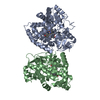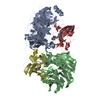[English] 日本語
 Yorodumi
Yorodumi- PDB-2i3o: Crystal structure of gamma-glutamyl transferase related protein f... -
+ Open data
Open data
- Basic information
Basic information
| Entry | Database: PDB / ID: 2i3o | ||||||
|---|---|---|---|---|---|---|---|
| Title | Crystal structure of gamma-glutamyl transferase related protein from Thermoplasma acidophilum | ||||||
 Components Components | Gamma-glutamyltransferase related protein | ||||||
 Keywords Keywords | TRANSFERASE / Gamma-glutamyl transferase related protein / Thermoplasma acidophilum / 6324d / Structural Genomics / PSI / Protein Structure Initiative / New York SGX Research Center for Structural Genomics / NYSGXRC | ||||||
| Function / homology | : / Gamma-glutamyltranspeptidase / Gamma-glutamyltranspeptidase, small subunit / Nucleophile aminohydrolases, N-terminal / Gamma-glutamyltransferase related protein Function and homology information Function and homology information | ||||||
| Biological species |   Thermoplasma acidophilum (acidophilic) Thermoplasma acidophilum (acidophilic) | ||||||
| Method |  X-RAY DIFFRACTION / X-RAY DIFFRACTION /  SYNCHROTRON / SYNCHROTRON /  SAD / Resolution: 2.03 Å SAD / Resolution: 2.03 Å | ||||||
 Authors Authors | Rao, K.N. / Eswaramoorthy, S. / Burley, S.K. / Swaminathan, S. / New York SGX Research Center for Structural Genomics (NYSGXRC) | ||||||
 Citation Citation |  Journal: To be Published Journal: To be PublishedTitle: Crystal structure of gamma-glutamyl transferase related protein from Thermoplasma acidophilum Authors: Rao, K.N. / Eswaramoorthy, S. / Burley, S.K. / Swaminathan, S. | ||||||
| History |
|
- Structure visualization
Structure visualization
| Structure viewer | Molecule:  Molmil Molmil Jmol/JSmol Jmol/JSmol |
|---|
- Downloads & links
Downloads & links
- Download
Download
| PDBx/mmCIF format |  2i3o.cif.gz 2i3o.cif.gz | 403.7 KB | Display |  PDBx/mmCIF format PDBx/mmCIF format |
|---|---|---|---|---|
| PDB format |  pdb2i3o.ent.gz pdb2i3o.ent.gz | 331.3 KB | Display |  PDB format PDB format |
| PDBx/mmJSON format |  2i3o.json.gz 2i3o.json.gz | Tree view |  PDBx/mmJSON format PDBx/mmJSON format | |
| Others |  Other downloads Other downloads |
-Validation report
| Summary document |  2i3o_validation.pdf.gz 2i3o_validation.pdf.gz | 459.4 KB | Display |  wwPDB validaton report wwPDB validaton report |
|---|---|---|---|---|
| Full document |  2i3o_full_validation.pdf.gz 2i3o_full_validation.pdf.gz | 488.4 KB | Display | |
| Data in XML |  2i3o_validation.xml.gz 2i3o_validation.xml.gz | 78.7 KB | Display | |
| Data in CIF |  2i3o_validation.cif.gz 2i3o_validation.cif.gz | 110.2 KB | Display | |
| Arichive directory |  https://data.pdbj.org/pub/pdb/validation_reports/i3/2i3o https://data.pdbj.org/pub/pdb/validation_reports/i3/2i3o ftp://data.pdbj.org/pub/pdb/validation_reports/i3/2i3o ftp://data.pdbj.org/pub/pdb/validation_reports/i3/2i3o | HTTPS FTP |
-Related structure data
| Similar structure data | |
|---|---|
| Other databases |
- Links
Links
- Assembly
Assembly
| Deposited unit | 
| ||||||||
|---|---|---|---|---|---|---|---|---|---|
| 1 | 
| ||||||||
| 2 | 
| ||||||||
| Unit cell |
|
- Components
Components
| #1: Protein | Mass: 57578.977 Da / Num. of mol.: 4 Source method: isolated from a genetically manipulated source Source: (gene. exp.)   Thermoplasma acidophilum (acidophilic) / Production host: Thermoplasma acidophilum (acidophilic) / Production host:  #2: Water | ChemComp-HOH / | Has protein modification | Y | |
|---|
-Experimental details
-Experiment
| Experiment | Method:  X-RAY DIFFRACTION / Number of used crystals: 1 X-RAY DIFFRACTION / Number of used crystals: 1 |
|---|
- Sample preparation
Sample preparation
| Crystal | Density Matthews: 2.69 Å3/Da / Density % sol: 54.34 % |
|---|---|
| Crystal grow | Temperature: 293 K / Method: vapor diffusion, sitting drop / pH: 5.5 Details: Magnesium Formate, pH 5.5, VAPOR DIFFUSION, SITTING DROP, temperature 293K |
-Data collection
| Diffraction | Mean temperature: 100 K |
|---|---|
| Diffraction source | Source:  SYNCHROTRON / Site: SYNCHROTRON / Site:  NSLS NSLS  / Beamline: X12C / Wavelength: 0.9795 Å / Beamline: X12C / Wavelength: 0.9795 Å |
| Detector | Type: ADSC QUANTUM 210 / Detector: CCD / Date: Jun 14, 2006 / Details: Mirrors |
| Radiation | Monochromator: Si(111) / Protocol: SINGLE WAVELENGTH / Monochromatic (M) / Laue (L): M / Scattering type: x-ray |
| Radiation wavelength | Wavelength: 0.9795 Å / Relative weight: 1 |
| Reflection | Resolution: 2.03→50 Å / Num. all: 156657 / Num. obs: 156657 / % possible obs: 99.6 % / Observed criterion σ(F): 0 / Observed criterion σ(I): 0 / Redundancy: 7.4 % / Biso Wilson estimate: 11.4 Å2 / Rmerge(I) obs: 0.095 / Net I/σ(I): 11.5 |
| Reflection shell | Resolution: 2.03→2.1 Å / Redundancy: 6.5 % / Mean I/σ(I) obs: 3 / Num. unique all: 15286 / Rsym value: 0.38 / % possible all: 97.9 |
- Processing
Processing
| Software |
| ||||||||||||||||||||||||||||||||||||
|---|---|---|---|---|---|---|---|---|---|---|---|---|---|---|---|---|---|---|---|---|---|---|---|---|---|---|---|---|---|---|---|---|---|---|---|---|---|
| Refinement | Method to determine structure:  SAD / Resolution: 2.03→30.47 Å / Rfactor Rfree error: 0.003 / Data cutoff high absF: 92146.53 / Data cutoff low absF: 0 / Isotropic thermal model: RESTRAINED / Cross valid method: THROUGHOUT / σ(F): 0 / Stereochemistry target values: Engh & Huber SAD / Resolution: 2.03→30.47 Å / Rfactor Rfree error: 0.003 / Data cutoff high absF: 92146.53 / Data cutoff low absF: 0 / Isotropic thermal model: RESTRAINED / Cross valid method: THROUGHOUT / σ(F): 0 / Stereochemistry target values: Engh & HuberDetails: Residues listed in remark 465 and atoms listed in remark 470 were not modeled due to lack of electron density. Residue ASN254 in all four chains does not have good geometry. However, they ...Details: Residues listed in remark 465 and atoms listed in remark 470 were not modeled due to lack of electron density. Residue ASN254 in all four chains does not have good geometry. However, they fit the electron density very well. Residual densities near the active sites have been modeled as water (39, 40, 45, 167) but they could be metal ions. N terminal Selenomethionine is visible only in chains A and D.
| ||||||||||||||||||||||||||||||||||||
| Solvent computation | Solvent model: FLAT MODEL / Bsol: 40.6224 Å2 / ksol: 0.369856 e/Å3 | ||||||||||||||||||||||||||||||||||||
| Displacement parameters | Biso mean: 19.7 Å2
| ||||||||||||||||||||||||||||||||||||
| Refine analyze |
| ||||||||||||||||||||||||||||||||||||
| Refinement step | Cycle: LAST / Resolution: 2.03→30.47 Å
| ||||||||||||||||||||||||||||||||||||
| Refine LS restraints |
| ||||||||||||||||||||||||||||||||||||
| LS refinement shell | Resolution: 2.03→2.16 Å / Rfactor Rfree error: 0.01 / Total num. of bins used: 6
|
 Movie
Movie Controller
Controller












 PDBj
PDBj




